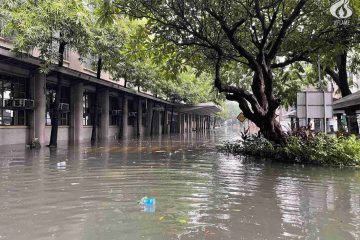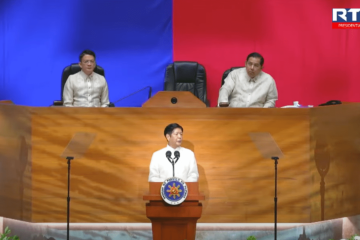by CHRISTINE DIANE R. ALMANZOR and DENISE ANGELA E. SALAZAR

(Editor’s note: As the Philippines commemorates the 50th anniversary of Martial Law, The Flame is republishing this article, which appeared in its vol. 47, issue no. 3.)
The years of martial rule have been deemed by some as the darkest age in the country’s history. It was marked by unjust killings, human rights violations, and unceasing abduction of opposition members, all feigning to curb rebellion. Despite the threats given to those who are opposing the martial rule, the Artlet community remained true to its liberal thinking by leading Thomasians in voicing out their clamor for change and reform in the country.
THE ISSUANCE of Proclamation No. 1081 by the late president Ferdinand Marcos on Sept. 21, 1972 was supposed to suppress the rising surge of violence and to wipe out the roots of rebellion in the country allegedly caused by communists. At some point, Martial Law served its true purpose, but as authorities abused their power, it became a nightmare for some Filipinos whose human rights were violated.
The declaration of Martial Law changed the course of Philippine history forever as it marked the beginning of a new battle for freedom against a dictator who had a great obsession with power.
During this era, the whole nation was shrouded with fear and turmoil, human rights violations were rampant, communication and media companies were sequestered by the administration, and opposition leaders were abducted.
Despite these injuries, the Filipinos’ clamor for freedom and liberation did not falter. Organizations opposing the martial rule were born. Human rights groups emerged and the flame of student activism ignited stronger than ever.
Evident of this cause were students from the Faculty of Arts and Letters (Artlets) who led the Thomasian community’s fight for freedom.
Fight for liberalism

After Martial Law was declared, student organizations opposing it were prohibited in colleges and universities. This condition forced the students to organize underground societies as their means to fight the Marcos administration. As stalwarts of liberalism, Artlets students were at the front line of Thomasian activism. They organized and led various anti-government propaganda. They formed underground societies and empowered student participation in the clamor for freedom. Symposia and lightning rallies were also conducted.
One of the underground societies formed was the Fraternal Organization of the University of Santo Tomas led by the UST Tau Gamma Phi Fraternity under Atty. Jay De Castro. The FROUST was one of the Thomasian groups who fought against and condemned the abuses of Martial Law.
“Since there was no student council, Tau Gamma united all fraternities in UST into one single organization that we called FROUST,” De Castro, former UST Tau Gamma Phi Fraternity leader, told The Flame.
The activities started by De Castro’s group against Martial Law eventually inspired other Thomasians to fight for their rights as students. Others joined the lightning rallies around the campus and participated in Operation Pinta demonstrations.
Operation Pinta was the act of painting the University walks with graffiti bearing student grievances.
According to De Castro, being a student leader was never easy and safe during the military-ruled government of Marcos. There were issues of human rights violations, assassinations were taking place everywhere, and abductions of student activists were out of control.
He was accused of mauling a student who happened to have relatives at the Philippine Air Force (PAF). No warrant of arrest was presented to him, yet the military insisted on bringing him to Camp Crame. Fortunately, members of FROUST saw the incident and stopped the military from taking him.
“There was a time when I almost got abducted by the military and PAF officials,” the communication arts alumnus said, noting the experience he had during the height of Martial Law in 1976.
“If not for the students who stopped the PAF officials, I could have been tortured,” he said, describing the tumultuous tug-of-war emerging between the students and the military.
He was sentenced in court to 10 years and eventually got acquitted after successfully defending himself when he passed the bar examination.
“It was very painful to fight for something that you know you did not do,” he added.
Meanwhile another student activist who also fought during the Marcos era was former Artlets Student Council (ABSC) president Cornelio “Jun” Carmona.
“In 1981, there was a specific memorandum that allowed the establishment of student councils in universities. On that note, the first student council election in Artlets was conducted in 1982,” Carmona told The Flame.
Prior to this election, Carmona said that a group students drafter a constitution containing the by-laws and policies of the council election. It was later approved by the student body.
In the third ABSC election, Carmona ran as the council president and won. While in his senior year, he assumed the position of the student council and at the same time worked as the associate editor of The Flame. These positions played a crucial role in the liberal expression of his thoughts as a student leader.
During Carmona’s tenure, the Office for Student Affairs did not officially recognize political parties and other organizations with pronounced political agendas, but this did not stop him and his colleagues to fight against martial rule.
“As resistance to Martial Law, we [ABSC] held symposia about various political topics. It was open for everyone, but majority of the audience came from our Faculty. We coordinate such projects to the Central Student Council, who was very cooperative, but not as aggressive as Artlet students,” Carmona said.
According to him, one of the major issues during his time was the Filipinization that pertained to the controversy arising from Spanish Dominicans who still hold administrative positions in the University. They also confronted concerns pertaining to uniform reform.
“The [administration] required us to wear black pants and polo shirt. We were demanding to wear maong pants. We organized big protests to the point that we even burned black pants in front of the building,” Carmona said.
Their protests and efforts finally paid off when the administration conceded and allowed male Artlets to wear maong pants as part of their uniform. Freshmen students were not covered by the directive. Carmona considered this incident as one of the council’s major accomplishments.
Carmona added that the Artlets Student Councils who served during the Martial Law proved to be the most active and most vocal student government in the University.
“In fact, the Central Student Council by then obtains support from the ABSC. We [ABSC] literally decide on things. ‘Pag sinabing boycott, lahat ng mga estudyante nagbababaan. ‘Pag sinabing magrarally, lahat sumasama,” he said.
Meanwhile, the assassination of Benigno “Ninoy” Aquino Jr. coincided with Carmona’s term. As described by Carmona, Aquinos’s death changed everything.
“There was an outpouring of sentiments over the martyrdom of Ninoy. This triggered the whole Thomasian community to unite,” he said.
For De Castro and Carmona, Martial Law had its way of changing people and transforming their lives.
Class Lawsuit
After the Marcoses fled the country in 1986, human rights victims who suffered during the span of martial rule filed a class suit against the strongman. Twenty-five years later, the suit favored the complainants and they began to receive their initial $1,000 (roughly P43,000) compensation.
Winning the class lawsuit made history as it was the first in Asia to be pushed after two and a half decades of struggle. The distribution of checks began early this year and was established in 16 processing centers nationwide.
Lawyer Rod C. Domingo Jr., one of the legal counsels of the claimants, said that as of August 7, 2011, 97 percent of the 7,526 (originally 9,539) listed victims have already claimed their checks.
“We were able to recover $10 million dollars from the corporation organized by Jose Y. Campos, once an ally of Marcos and the owner of United Laboratories (UniLab) in Texas and Colorado. The corporation settled for ten million dollars and were distributed among the victims.” Domingo told the Flame.
Despite the $10 million recovery, only $7.5 million went to the claimants as the remaining $2.5 million were used for litigation and other legal expenses.
Amid the distribution of the $10 million among the victims, Domingo, with his counsel and petitioners, still strives for a separate $68 million claim in Singapore and New York.
“Pending today are two separate cases, one in New York and another in Singapore. If we win in any of the cases, we will make another distribution depending on the amount will recover. Domingo said.”
According to him, They are still pursuing more cases so they can provide the claimants additional compensation.
“We are still trying to file all cases. Until now, we are still looking for the ill-gotten wealth hidden abroad. We are still pursuing more. Kapag may nabalitaan kami hanggang ngayon, hahabulin namin yon nang walang tigil,” Domingo said.
Domingo explained he is hopeful that even if the government becomes hesitant to forgo its claim on the recovery cases, it is still amenable to a deal that would be favorable to the human rights victims.
“We are working hard to win cases that are being opposed vigorously by the Presidential Commission on Good Governance on the belief that since it is a form of ill-gotten wealth, it should go to them [PCGG],” Domingo said. F



